Shevlin Sebastian's Blog, page 85
September 6, 2016
A Rifle In Plain Sight
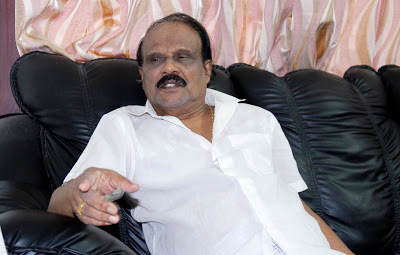
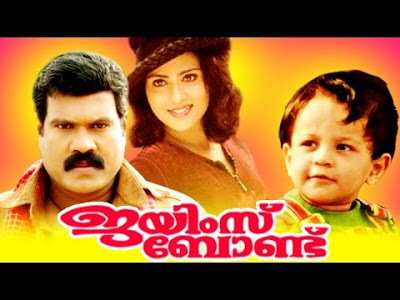
COLUMN: LOCATION DIARY
Veteran scriptwriter Kaloor Dennis talks about his experiences in the films, ‘James Bond’ and 'Minimol Vathicanil'
Photos: Kaloor Dennis by Ratheesh Sundaram; the poster of the film, 'James Bond'
By Shevlin Sebastian
When scriptwriter Kaloor Dennis was introduced to the producer of the film, 'James Bond' in 1997, he got a surprise. His name was Noor, a Malayali, who had come from Mumbai. This was Noor's first film.
“After reading the script, he okayed it,” says Dennis. “Noor was very prompt with the payments. Before the movie began he gave me the full amount for writing the script.”But whenever Dennis went to meet Noor, at an apartment in Kochi, there would be a rifle in plain sight, on the table in front of him.
The film was loosely based on the 1994 Hollywood hit, 'Baby's Day Out'. But when director Baiju Kottarakkara suggested getting a local baby to play the main lead, Noor insisted on his baby. “It was a foreign child,” says Dennis. So Baiju had to agree.
“From the beginning Noor had issues with Baiju,” says Dennis. “He would tell me, 'He is not okay'. I had a suspicion that Noor was connected to the underworld in Mumbai.”
Meanwhile, there were other dramatic developments. Kalabhavan Mani had a role in the film. On the day he was supposed to join the set, he went missing. When Noor heard that Mani had gone to another film set, at Mundakayam, he became incensed. He ordered ten henchman to come from Mumbai. When they landed, they went and met Mani, and threatened him.
The frightened actor returned with the hoodlums, and ensured that he finished his schedule on time. But, later, he complained about the threats to the Association of Malayalam Movie Artistes (AMMA). The organisation launched an investigation. “But Noor did not care a damn about AMMA,” says Dennis.
Meanwhile, the shooting came to a sudden halt because the baby fell ill. When the director suggested getting another baby Noor refused. Eventually, Noor lost interest. He upped and returned to Mumbai with his gang members. Then Baiju got another producer, a new baby and completed the film. “It did reasonably well at the box office,” says Dennis. “But none of us will ever forget Noor.”
Dennis will also not forget the location shoot in Germany for 'Minimol Vathicanil'. One day, in September, 1984, director Joshy as well as actors, Soman, Saritha and Dennis were travelling in a car near Berlin. “I was sitting in front, while the other three were at the back,” says Dennis. “And we were having a lively conversation. Suddenly I began to hear a sound. I was not sure whether it had anything to do with the car. But I had an intuition that something was wrong.”
So Dennis told the driver to stop the vehicle. And when he stepped out Dennis got a shock. “The front tyre, on the left side, was completely shredded,” he says. “We were moments away from a major accident.” His colleagues thanked him profusely. “Ever since then whenever Soman would meet me, he would call me his guardian angel,” says Dennis.
Meanwhile, after 25 days, Dennis, Ratheesh, Saritha, Swapna, Baby Shalini and her father Babu went to Frankfurt airport to return to Kerala. They checked in their luggage, and wandered about. Eventually, they arrived 45 minutes before the departure at the boarding gate, but were denied permission to embark. “We were supposed to check in two hours before. As a result, we missed the flight, but our luggage was loaded,” says Dennis.
Later, when they landed in Mumbai, they did get their luggage, but many items went missing. “It was lying unattended for two days, so somebody took the opportunity to steal something,” says Dennis.
(The New Indian Express, Kochi, Thiruvananthapuram and Kozhikode)
Published on September 06, 2016 22:44
September 4, 2016
A Rumination About Death
 Bollywood star Kalki Koechlin talks about the English language play, 'The Living Room', which she has written and directed
Bollywood star Kalki Koechlin talks about the English language play, 'The Living Room', which she has written and directedPhotos by Ratheesh Sundaram
By Shevlin Sebastian
In the opening scene of the English language play, 'The Living Room', actor Neil Bhoopalam, as Death, is sitting on a stool. He has a white face, a red bandana across his forehead, a black overcoat and red shoes. He looks at the elderly house owner Anna Nils (played by Sheeba Chadha), who is sleeping on a sofa in the living room of a house, and says, “Anna Nils, are you ready?”
And when Anna shakes her head, Death says, “She is not ready.” Then Anna says, “Are we on TV? Is it one of those shows?”
This elicits laughter amongst the audience at the JT Pac, Kochi, during a performance on August 21. 'The Living Room' is a moving, as well as humorous rumination about death, about our childhood memories, and the thoughts that go through our mind when we are told that the end is near.
The play has been written by Bollywood star Kalki Koechlin, who is also its first-time director. Asked about the inspiration behind the play, Kalki says that, two years ago, she woke up in the middle of the night, at her home, in Mumbai, and wrote down two pages of a conversation between an old woman and death.
“Of course, I have been touched by death, like everybody else,” she says. “My grandparents died when I was quite young. Those were big experiences for me. My parents are dealing with sickness and the fragility of old age. All these may be the reasons.”
Incidentally, this is the first play that Kalki is directing. And she had some nerve-wracking moments. When the play opened in Bangalore, a few months ago, during the first ten minutes, there was a complete silence. “I was thinking, 'Are they not understanding the play? It is supposed to be a comedy',” she says. “But suddenly a chuckle came and it was such a relief for me. Now, everyone felt they could laugh. People thought that because the subject was death, you are not supposed to laugh.”
Clearly, she is learning from her experiences, and also enjoying her stint as director. “For three months, before the show opens, you are working very hard, doing the music, lighting, costumes, overlooking the production details, and handling the actors,” says Kalki. “Then when the curtain goes up, you become an audience member. And it is such a pleasure to watch it unfold in front of you. Seeing your actors discover new things in the script is also a thrill.”
Asked about the charm of theatre, as opposed to film, Kalki, who has acted in films like 'Dev D' and 'Margarita with a Straw', says, “A play keeps evolving, unlike a film, which, when it is complete, is over. I keep changing the music and the lighting. Some of the scenes have been re-written. The spontaneity of a live audience helps you to be on your toes all the time.”
But can English-language theatre be able to stand on its own two feet? An optimistic Kalki says, “Theatre has always struggled to exist, even in Shakespeare's time. But it will survive, because theatre is a part of life. It is all about questioning the norm and expressing societal changes.”
(Sunday Magazine, The New Indian Express, South India and Delhi)
Published on September 04, 2016 22:27
September 2, 2016
In Mother's Abode, All Walls Will Fall
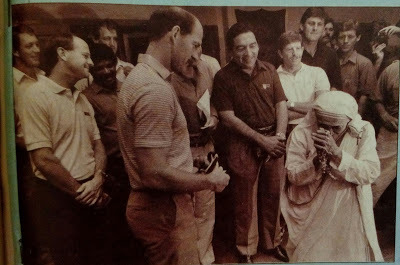 A group of South Africans met Mother Teresa for the first time
A group of South Africans met Mother Teresa for the first timePhoto: South African officials and cricketers including captain Clive Rice (in forefront) with Mother Teresa at Kolkata in 1991. Photo courtesy: Sportsworld magazine, The ABP Group, Kolkata
By Shevlin Sebastian
At 4 p.m. on a day in November, 1991, Mother Teresa walked to the verandah of the first floor of the Missionaries of Charity in Kolkata. The group of people who had been sitting, on two benches, got up. They had a look of awe, respect and affection.
Mother came and stood in the middle of the group, a short, stooping figure, with a wonderful smile on her face. “Thank you very much for coming,” she said.
“Yes Mother,” said Geoff Dakin, the president of the United Cricket Board of South Africa (UCBSA). “We have come to give you a donation.”
Mother said, “Oh thank you very much for your concern for God’s work.” She was speaking very softly that all the people had to bend their heads to hear, especially the 6’2” Geoff.
Suddenly, she said, “My, what a big packet you have given me.”
“Yes, it contains Rs 1 lakh rupees,” said Krish Mackerdhuj, Vice President of UCBSA.
“One lakh!” said Mother. “Thank you very much. We need the money. We could open a Children’s Home in Cape Town.”
The normally loquacious Krish was at a loss for words. So also were the two South African journalists, Carl Bongi, a black, and Gerald Dekock, a white, both of the South African Broadcasting Corporation.
Earlier, while waiting for Mother, Krish, of Indian origin, told me, “We had not planned to give a donation. But when we saw the work that she was doing, we felt compelled to help in some way. And the Board decided to give this money.”
Then he turned to Bongi and said, “Hey, Bongi, do you want to buy a baby tiger, to take back home?”
“A baby tiger,” said Bongi. “Where can you get them?”
Krish said, “You can get them at any corner of Calcutta. It is not very expensive. It will be a good gift.”
Bongi rubbed his crinkly black hair, his eyes wide open and astonished, and then he saw a smile slowly break out on Krish’s face.
“Hey man,” he said, as realisation dawned on him. “You are pulling my leg!”
The white journalist Gerald asked Bongi, “Where do you live?”
“I live in Soweto, but I am planning to move out,” said Bongi. “There is too much violence there.”
It was remarkable that these two people, both in their thirties and working in the same company, did not know where the other lived. They seemed to be bridging the colour barrier for the first time.
Was this the effect of Mother Teresa?
Two people, in a building of love, thousands of kilometres away from home, taking the first tentative steps across the racial divide.
Does love triumph in the end?
(Published as a middle in the New Indian Express, South India editions)
Published on September 02, 2016 22:00
September 1, 2016
All About God And Human Desires
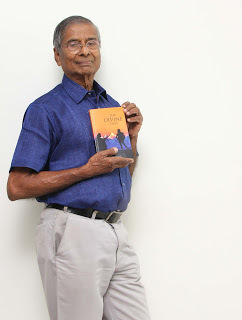 The Muvattupuzha-based lawyer Baby Kattackal has just released his third novel, 'The Divine Lust'
The Muvattupuzha-based lawyer Baby Kattackal has just released his third novel, 'The Divine Lust'Photo by Albin Mathew By Shevlin Sebastian The late Yohannan Kattackal was one of the leading lawyers in Muvattupuzha. So, it was no surprise that when his son, Baby, grew up, he also became a lawyer. But, along the way, Baby developed another love: this was for writing. His elder sister Chinamma would encourage him to read. She would bring him books to read, whenever she came from college in Chennai. “Sometimes, I would find the words tough to understand,” says Baby. “So she suggested that I should consult a dictionary. As a result, my vocabulary improved steadily.” Soon, Baby began writing letters to the editor in 'The New Indian Express'. “I also contributed numerous middles also,” he says. In his later years, Baby turned to story-writing and published many stories in national magazines like 'Alive' and 'Woman's Era'. And, recently, Baby published his third novel, called 'The Divine Lust'. The story is about Robin, who got married to the religious-minded Romula. “She would always say she wants to live and die in God,” says Baby. “As a result, Romula was frigid. But, in the first month, she got pregnant and then got divorced from her husband.” The novel is about how Julie, the daughter, grows up, becomes a researcher in psychology, and then questions her mother about her religious beliefs. Following the questioning, this is the conclusion that Julie tells Romula: “Your love was fixed on God long before you reached a marriageable age. Then your mind refused to accept the normal sexual development, which, according to [Sigmund] Freud, [the father of psychoanalysis], was oral, anal and genital. Your sex couldn't develop into the normal final stage, which was genital. If your mind had reached this final stage, you wouldn't have had the problem of frigidity.”
'The Divine Lust' is a novel of ideas, thought-processes, philosophical and psychological value systems. And it can be thought-provoking, too.
Baby had published two novels earlier: 'The Crusaders', and 'The Guardians of Evil'. But he is a bit worried by the declining reading habit among the people. “When I gave 'Divine Lust' to my friends, they just could not find any time to read it,” says Baby. “People are leading busy lives.” But that has not discouraged Baby. “I plan to continue writing more novels,” he says.
(Published in The New Indian Express, Kochi and Thiruvananthapuram)
Published on September 01, 2016 23:29
August 31, 2016
Providing Succour To the Islands
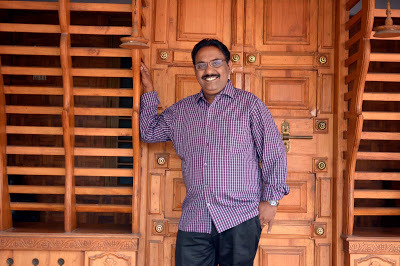
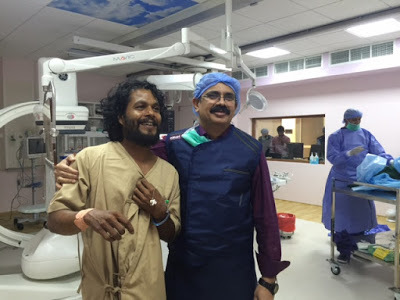
A small group of doctors from Kerala travel regularly to the Maldive Islands to provide treatment
Photos: Dr. S. Radhakrishnan. Photo by Manu R Mavelil; Dr. N Prathap Kumar
By Shevlin Sebastian
At Malé airport, on the Maldive Islands, recently, a 75-year-old woman hailed the Thiruvananthapuram-based dermatologist Dr S Radhakrishnan Nair.
Radhakrishnan was puzzled. He could not recognise the woman. Then she told the doctor that he had treated her a year ago, at a medical camp, on one of the islands. “She had been suffering from chronic dermatitis,” says Radhakrishan, “But when I saw her again, she had been relieved of her symptoms. So, she was very happy to meet me.”
Radhakrishnan has been going to the Maldives for the past two years. He is associated with a private hospital called Maldicare. “I go once a month, or, sometimes, once in two months,” he says. “There are a lack of doctors there.”
Some of the common skin diseases the people suffer from, are fungal infections and psoriasis. “Since they are always in water, because of their work as fishermen, they have fungal infections,” he says. “As for the prevalence of psoriasis it is a genetic condition.”
Malayali doctors, belonging to different categories, like dentists, physicians, cardiologists, neurologists, and surgeons, go to the Maldives. But the numbers are low. So the Maldivian government provides full health insurance, apart from flight tickets, to enable its citizens to get treatment abroad.
Hence, patients travel to Thiruvanathapuram and Bengaluru, Colombo, Singapore, Bangkok and Jakarta, to get treatment. Amazingly, one rufiyaa (Maldivian currency) fetches 4.2 Indian rupees. “That makes it easier for them to come to Kerala,” says Radhakrishnan.
Meanwhile, last month, cardiologist Dr. N Prathap Kumar, the managing director of the Meditrina Hospital at Thiruvananthapuram set up The National Cardiac Centre (NCC) at the government-run Indira Gandhi memorial hospital at Malé. “This is the first unit in the country,” says Prathap.
And the cardiologist had specific reasons to set it up. “The country saves a lot of money,” he says. “Even if I charge 30 per cent more, it is much less than what they are paying when they go abroad. Secondly, cardiac treatment is always needed as an emergency. The people can get treatment in their homeland, in the presence of their near and loved ones.”
Agrees Maldivian cardiologist, Dr. Ali Shafeeq, “Though medical care abroad is free, people face many difficulties when they travel abroad. So, they are happy to get treatment at home.”
The NCC unit has three cardiologists, as well as nursing staff. And they are paid well. While a cardiologist gets Rs 6 lakh a month, nurses earn anywhere between Rs 50,000 to 90,000, depending on overtime. And it has been a hectic time so far.
"We have done 110 procedures in the first month,” says Prathap. “I do all the complex cases. Most people suffer from heart attacks, valve diseases and blocks. The problem is that about 90 per cent of the population, including the women, are smokers. That is not healthy.”
Prathap goes to the Maldives twice a week. Recently, he reached Maldives at 11.30 p.m., and started the operations next day at 4.45 a.m. “I managed to do 22 procedures, but, by 3 p.m. I was at the airport, to go back,” he says.
However, Prathap says that not everybody is happy with his initiative. “They are missing the chance to go abroad,” he says. “Some hospitals in Thiruvananthapuram have lost customers. Travel agents have lost business all because of me. But I still believe that when an emergency happens, the only way to save lives is to have a cardiac unit at Malé.”
Ali says, “Yes, indeed. We have been able to save many lives and improve the quality of life of many patients by timely interventions. So, having a cardiac unit in Malé is a true blessing.”
(The New Indian Express, Kochi and Thiruvananthapuram)
Published on August 31, 2016 22:59
Panic During A Gas Leak
 COLUMN: LOCATION DIARY
COLUMN: LOCATION DIARYActor Esther Anil talks about her experiences in the Malayalam and Tamil versions of 'Drishyam'
Photo by Swaroop Sankar
By Shevlin Sebastian
At a bungalow, outside Thodupuzha, during the shoot of the Malayalam film, 'Drishyam', in October, 2013, a birthday cake was being cut for Murali, Mohanlal's costume designer. The crew was keen to have a piece, as well as ladoos and other snacks. So they were hovering around the table. But, suddenly, a gas cylinder began to leak at the back of the house.
“I saw [director] Jeethu Uncle and his wife Linta Aunty running into the nearby rubber plantation,” says child artist Esther Anil. Mohanlal, who was in his room, also got the message. Soon, he hurried out.
“Very soon, panic set in,” says Esther. “Then we all began to run.” However, in the melee, Esther and her mother, Manju, fell to the ground. “We felt dazed,” says Esther. “In the end we managed to move away.”
It took a while before the leak was stopped. The people then trooped back, and shooting resumed once again.
During one scene, Kalabhavan Shajohn, who dons the role of Constable Sahadevan, is supposed to kick Mohanlal, who plays cable business operator Georgekutty, on the chest. “Lalettan told Shajohn Chettan to give an actual kick,” says Esther. “Otherwise, it would not be realistic.”
So Shajohn raised his leg, and, at that moment, he slipped, and fell flat on his back. “The entire crew began laughing,” says Esther. “Lalettan also laughed out aloud. Shahjohn Chettan felt embarrassed. After all, he was supposed to be a policeman.”
Meanwhile, during the shoot of 'Papanasam' [the Tamil version of 'Drishyam'], again, at Thodupuzha, one day, actress Gautami told Esther and Manju that Michelle Mann, from New Zealand, a friend of Shruti Haasan [Kamal Haasan's daughter] was coming to visit the town.
So, one day, all of them, including Michelle, went on a road trip.
On the way, Michelle read a board which said, 'Toddy'. She asked what it was. “We told her it is a drink,” says Esther. “She wanted to taste it. So, my mother and I went into the shop and bought a small bottle.”
When they gave it to her, Michelle tightened the cap and said she would try it in her hotel room. “The next day, in the presence of Kamal Sir, we asked Michelle whether she liked the toddy,” says Esther. “Michelle replied that she could not taste a single drop.”
When she unscrewed the cap, the contents burst out and fell all over the floor. “One reason was because it had been screwed too hard,” says Esther. “Another was that, in the car, the bottle had received a lot of jolts. And all that contributed to the explosion.”
Later, for the Telugu version of 'Drishyam', Esther and Manju had gone to Hyderabad for the shoot. But soon after they reached there, they realised that everybody spoke in Telugu.
“When we wanted a glass of water we had to show the action of drinking water,” says Esther. “The same was the case of ordering different types of food, like eggs and fish. After a while, we got used to it.”
Then, one day, a new chef arrived. When he asked what food they wanted, Esther went into the same elaborate actions. Finally, he said, in Malayalam, “'Mole', what exactly do you want to eat?”
Dasan was the only Malayali on the set. He told Esther, “Next time, you don't need to do any actions. Just tell me directly.”
The New Indian Express, Kochi, Kozhikode and Thiruvananthapuram)
Published on August 31, 2016 05:13
August 29, 2016
Making a Comeback
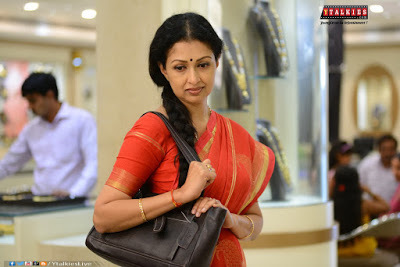 Gautami talks about teaming up with Mohanlal, after 18 years, in ‘Vismayam’, as well as her future plans
Gautami talks about teaming up with Mohanlal, after 18 years, in ‘Vismayam’, as well as her future plansBy Shevlin SebastianGautami breaks into a small laugh when she is told that the film, ‘Vismayam’, has been received well in Kerala. “That’s so nice to hear,” she says. She is starring alongside Mollywood superstar Mohanlal, who dons the role of an assistant manager in a supermarket. Asked why she chose the role, Gautami says, “I wanted to work with the director, Chandrasekhar Yeleti, because he is passionate about the type of films he wants to make.”Secondly, she liked the script. “Gayathri, the character I play, is like like most Indian woman, whose world is made up of her family and home,” says Gautami. The film has also been released in Tamil and Telugu. Gautami has teamed up with Mohanlal after 18 years. The last film they worked together was the Malayalam superhit, ‘His Highness Abdullah.’Asked how Mohanlal has changed, Gautami says, “There is a maturing and greater ease in his acting. All these years he has been honing his talent. So, he has a deeper understanding of the craft.”This is something that Gautami has missed. She left acting, nearly twenty years ago, so that she could, as a single mother, be with her daughter, Subbalakshmi, 24x7. “But I have no regrets about it,” she says. “I always did what I wanted to do, at every stage of my life. Subbalakshmi is 16 now and ready to go college. So I felt that this is the right time to return to films.”She is, of course, best qualified to compare the two legends, Kamal and Mohanlal. “Both have huge personas,” says Gautami. “And they have reached where they have, through dint of sheer hard work.”
But when told that it must have been easy for them because of their God-given talent and charisma, Gautami says, “I know of many people who have talent and charisma, but unless you are willing to put in a huge amount of struggle, it is very hard to make a mark.”
And making a mark is what Gautami plans to do now. “I would like to act in both mainstream and meaningful films,” she says. In fact, she has just signed, to act in a Tamil romantic comedy, with Prabhu Deva. “We are teaming up, after 26 long years,” she says, with a beaming smile. “It feels great to be back.”
(Sunday Magazine, The New Indian Express, South India and Delhi)
Published on August 29, 2016 23:10
The Face As Inner Mirror
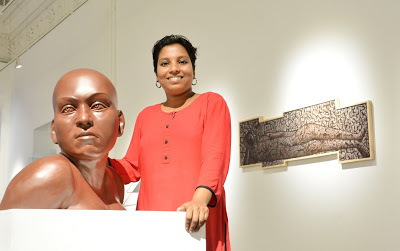
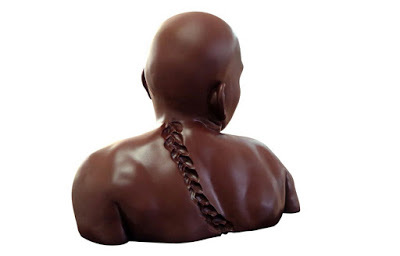 Sculptor EG Chithra’s work at the ‘Time Devoured’ exhibition is about her own face after she became bald
Sculptor EG Chithra’s work at the ‘Time Devoured’ exhibition is about her own face after she became baldPhotos: by Ratheesh Sundaram
By Shevlin Sebastian
Artist PV Nandan stares intensely at EG Chithra's sculpture, a self-portrait. “The eyes look sad, but the lips are determined,” he says. “There is a coiled energy in the face.” He caresses the bald head, which is on display at the 'Time Devoured' exhibition, held recently, at the Durbar Hall Art Gallery in Kochi. “It is an impressive work,” he says. “Although there are very few women sculptors in Kerala, Chithra is one of the best.”
Chithra's work, titled, 'Yes, I believe that this is something special', has a back story. At 6 p.m., on March 26, last year, she walked into the Aspinwall House, at Fort Kochi during the Kochi Biennale. Chithra was wearing a floor-length maroon gown, held an empty earthen pot in her hands, and had three dolls hanging on her back. She reached an area where a circle had been marked, with white chalk, on the ground.She is also making a mark with her works. But the artist stumbled on to sculpting by accident. When she applied to do a course in painting at the RLV College of Music and Fine Arts, in the suburb of Tripunithara, there were no seats. Instead, there was an opening in sculpture. So she opted for it and was able to complete the four-year course.
But life is not easy for this full-time artist, whose husband is a painter. “There are only a handful of artistes in Kerala who can live by selling their works,” she says. “The works of painters are not selling, so you can imagine the plight of sculptors.”
She has been able to make ends meet by being an occasional lecturer on art at different colleges, including her alma mater, RLV College. Thus far, Chithra has done about fifteen sculptures. One eye-catching one is of a woman lying supine, in mid-air, with her long flowing hair pointing towards the ground.
Most days, both husband and wife work in a rented studio at Fort Kochi. “I am living my passion, so I am happy, no matter the difficulties,” says Chithra.
(Sunday Magazine, The New Indian Express, South India and Delhi)
Published on August 29, 2016 02:35
August 24, 2016
Falling Face-Down

 COLUMN: LOCATION DIARY
COLUMN: LOCATION DIARYActress Kaniha talks about her experiences in the Tamil film, 'Five Star', the Telugu film, 'Ottesi Chepputunna', and an unexpected meeting with a Malayalam superstar
By Shevlin Sebastian
Kaniha was feeling happy. For her first film, 'Five Star' (2002), she was shooting in Berne, Switzerland. She was so enthusiastic that when there was no shoot involving her, she would stand beside the director, Susi Ganeshan, and use the clapperboard.
One morning, on the penultimate day of the shoot, the crew had got inside a bus. They were about to do a picturisation for the song, 'Thiru Thiruda'. As Kaniha stepped in, she realised that she had forgotten her jacket. So she ran out, went to the hotel, collected it, and returned.
As she was about to step into the bus, she slipped and landed face-down on the road. “I had blood all over my face,” she says. “I had no clue from where it was coming.”
The crew rushed her to a hospital, but it took almost an hour. While there, the doctors realised that there was a severe cut in the gums. So they stitched it together. When Kaniha stepped out of the hospital, she noticed that there was dried-up blood all over her dress.
Suddenly, the director said, “Let's shoot. We have to finish the schedule.”
Kaniha got a shock. “I was thinking to myself, 'What a cruel world I am living in',” she says.
During the shoot, they took shots of Kaniha, in silhouette, so that nobody could notice there was anything wrong with her. Says Kaniha, “It would take a few more years for me to realise that what Susi did was right. The producer had spent lakhs of rupees, so the shoot had to be finished on schedule. Otherwise, there would be cost overruns.”
In January, 2003, Kaniha had another chance to go abroad. This was for her first Telugu film, 'Ottesi Chepputunna'. The shoot was at Queenstown, New Zealand. Hero Srikkanth wore a gaudy yellow shirt and trousers, while Kaniha wore a green and red costume for the picturisation of a song.
“The crew placed us in the middle of a busy street,” says Kaniha. “Since the camera was placed on the top of a building, nobody could see it.” But thanks to a microphone in their ears, the actors would start dancing following instructions from the director E Sattibabu.
“We would dance, but the local bystanders thought that we were street performers, since they could not see the camera. So, they would throw coins at us,” says Kaniha. “It was so embarrassing. In between shots, I stood at one side and thought, 'What am I doing here? People are throwing money at me!'.” Somehow, the shoot concluded quickly.
But Kaniha did not want another event to end quickly. Recently, she took a morning flight from Chennai to Kochi. Feeling drowsy, she put on her sunglasses and went off into a deep sleep. “Suddenly, I felt somebody tap me,” she says. “I woke up, feeling very irritated. And then I got a shock.”
It was superstar Mohanlal. An ecstatic Kaniha shouted, “Lalettan.”
The last film they worked together was 'Spirit' (2012). “I had not seen him for a while,” she says. “When you are shooting or at an award function, you have very little time to talk to each other.”
But, this time, the duo enjoyed 50 minutes of uninterrupted conversation. “We talked about cinema, about Lalettan's projects,” says Kaniha. “He was open to talk about any subject. Lalettan is extremely well-read and knowledgeable. I could have an intelligent conversation with him. It was a memorable experience for me.”
(The New Indian Express, Kochi, Thiruvananthapuram and Kozhikode)
Published on August 24, 2016 01:52
August 22, 2016
Living by Bread Alone
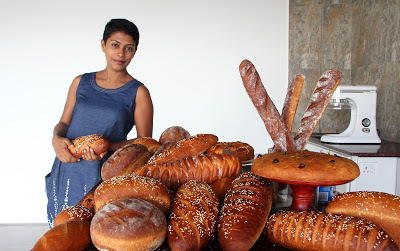
 Jeemol Koruth Verghese has been spreading the joys of home-made bread
Jeemol Koruth Verghese has been spreading the joys of home-made breadin Kochi
Photos by Albin Mathew
By Shevlin Sebastian
Rasheeda Begum, 30, felt depressed. She had asked permission from her conservative Muslim in-laws to attend a one-day baking class, at Kochi, conducted by Jeemol Koruth Verghese, but they said no. Her husband lives and works in West Asia.
Rasheeda threw several tantrums, and stopped having her meals. Finally, the family relented. But when she arrived at Kochi, from Guruvayur, 93 kms away, the mother-of-two was accompanied by two male relatives, who sat on the stairs, outside the door of Eva's Healthy Bakes, throughout the day, providing security for her.
In the end, it turned out well for Rasheeda. “She is a natural talent,” says Jeemol, 34. “Rasheeda picked up the techniques very quickly. And now she is baking all types of bread and has become a star in her locality. It has given a boost to her self-confidence.”
Jeemol's baking classes are growing in popularity in Kochi. “In a way, you can say, I am a 'bread activist',” she says, with a smile. “I want to make people eat home-made bread. It is so much more tasty.”
What Jeemol does not mention is that mass-baked bread has a lot of preservatives in it, so that it lasts a long time. The ingredients include gluten, palmolein, potassium sorbate, calcium propionate and sodium bezonate.
“A home-made loaf, which consists of unbleached organic flour and sugar, yeast, water, milk, oil, salt and egg, has a much shorter shelf-life,” says Jeemol. “The bread will go bad within two to three days. But if its refrigerated, it can last a week. To eat it, you just need to steam it.”
Among the many types that Jeemol makes, they include whole wheat bread, baguettes, organic semolina, cibatta, rosemary and braided breads, Olive Herbed Foccacia and the Jewish Challah.
“The Challah is a traditional Jewish bread, which is eaten on the Sabbath,” she says. “It is made with honey, olive oil, eggs, but has less sugar.”
But the most popular bread is the foccacia, from Italy. This is made of yeast, olive oil, thyme, herbs like rosemary or basil, black olives and caramalised onions. “Many of my students have never heard of this bread,” she says. “But when they take it home, the families love it. My children also like it a lot.”
Her classes are attended by women, who range in age from 16 to 65. And most of the participants are happy. Deepa Vijay says, “I attended Jeemol's class, without anyone's knowledge, and the next weekend I baked a yummy loaf and surprised my family, who always considered me as zilch in the kitchen. Now I realise that the step-by-step process of making bread is a stress-buster for my marketing job.”
Asked the secret to making a good bread, Jeemol says, “You need to make it with passion. I feel such a deep sense of satisfaction when the bread rises in the oven. I love the brown crust and the delicious smell. When I make bread at home, thanks to the aroma, it does not take long for my neighbours to know it. So, I always give them a few loaves.”
(Sunday Magazine, The New Indian Express, South India and Delhi)
Published on August 22, 2016 22:09



